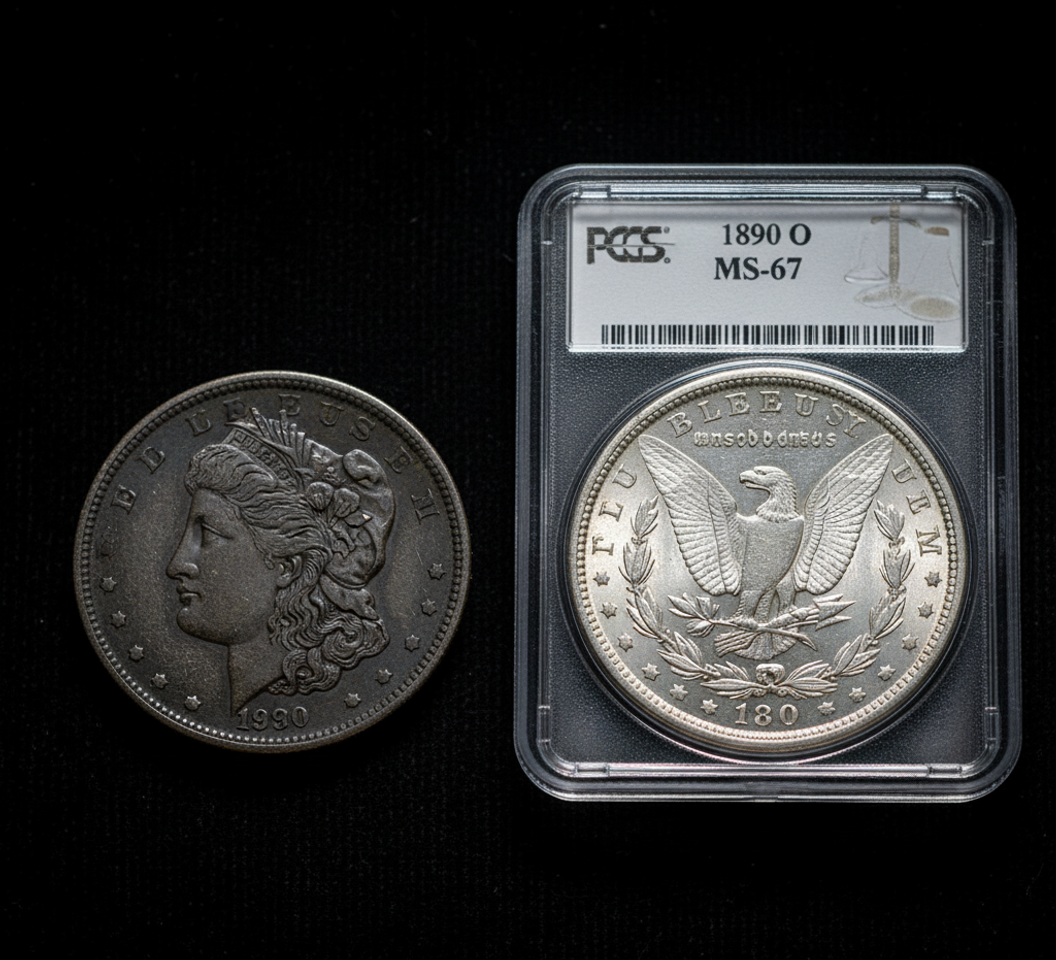Grading 101: What PCGS and NGC Mean and How They Determine a Coin's Value
The $50 vs. $5,000 Silver Dollar: Unlocking the Secret of Numismatic Value
Imagine two 1881-S Morgan Silver Dollars resting side-by-side. To the casual observer, they appear identical. Both are struck from 90% silver, bear the same iconic design of Lady Liberty, and possess the same historical weight. Yet, one of these coins holds a modest value of around $50, while the other commands a price tag of over $5,000. This is not a hypothetical scenario; it is a daily reality in the numismatic market. The question that every new collector and investor must ask is: what accounts for this staggering 100-fold difference in value?
The answer lies in a single, critical concept: the coin's "grade." The grade is a meticulous, professional assessment of a coin's physical condition. For collectible coins, this certified evaluation is the primary driver of value, often eclipsing the intrinsic worth of the precious metal it contains by orders of magnitude.
Beyond the Naked Eye: The Role of Third-Party Grading (TPG)
Third-party grading, or TPG, is a specialized service offered by independent companies that authenticate, attribute, and assess the condition of coins.
The outcome of this process is the encapsulation of the coin into a protective, sonically sealed plastic holder, commonly known as a "slab".
The creation of this system has had a transformative effect on the coin market, providing four core benefits:
-
Authentication: TPGs provide a guarantee of authenticity, protecting collectors from the sophisticated counterfeits and altered coins that can plague the market.
11 -
Standardization: Grading establishes a universal language for condition, allowing collectors and dealers across the globe to trade assets with confidence, often without ever seeing the coin in person.
15 -
Liquidity: By removing subjectivity and guaranteeing authenticity, TPGs foster immense consumer confidence. This confidence translates directly into a more liquid market, where certified coins are easier to buy and sell and frequently achieve higher prices.
11 -
Preservation: The slab itself is a state-of-the-art archival holder made of inert materials. It shields the coin from environmental damage, contaminants, and improper handling, preserving its condition—and thus its value—for generations.
12
The development of the slab did more than just protect coins; it effectively converted them into standardized financial instruments. Before the advent of TPGs, a coin's value was largely a matter of subjective, face-to-face negotiation between a buyer and seller. The slab, with its guaranteed grade and unique serial number, acts as an immutable certificate of quality backed by the grading service's reputation and financial guarantee.
The Gold Standard of Grading: An Introduction to PCGS and NGC
While numerous companies offer grading services, the market is dominated by two firms that have earned the unwavering trust of the numismatic community: the Professional Coin Grading Service (PCGS) and the Numismatic Guaranty Company (NGC).
Their emergence in the mid-1980s was a direct response to a chaotic and fragmented market. Before TPGs, coin grading was notoriously inconsistent. A dealer might assign a high grade to a coin when selling it, only to offer a much lower grade for the same coin when buying it back.
Over more than three decades, the unwavering consistency and accuracy of PCGS and NGC have made their holders the industry standard. Coins certified by these two services are universally accepted, are easier to sell, and consistently command higher prices at auction and in private sales than coins graded by other services or those left in a "raw," uncertified state.
Furthermore, these companies evolved beyond simple grading to become active participants in shaping the market. Services such as the PCGS Population Report and the NGC Census track every coin they have ever graded, creating a public database that allows collectors to gauge the relative rarity of a specific coin in a specific grade.
From Pocket Change to Perfection: Decoding the 70-Point Sheldon Scale
The universal language of coin condition is the 70-point Sheldon Scale. It was developed in 1948 by the renowned numismatist Dr. William Sheldon for his research on early American large cents.
To understand the grades, one must first understand the key criteria that graders evaluate:
-
Strike: This refers to the sharpness and completeness of a coin's design details, resulting from the force of the die striking the metal blank during manufacturing.
22 -
Luster: This is the original, satiny sheen that a freshly minted coin exhibits when it reflects light. It is one of the first things to be disturbed by wear.
22 -
Marks/Hairlines: These are post-strike imperfections, such as scratches or abrasions, that a coin acquires from contact with other coins (e.g., in a mint bag) or from handling.
-
Eye Appeal: A comprehensive, albeit subjective, assessment of a coin's overall visual attractiveness, combining factors like toning, luster, and strike quality.
22
It is essential to distinguish between a coin's strike and its preservation. The strike is a characteristic of its manufacture; a coin can leave the press with a weak strike and soft details due to worn dies or improper pressure. Preservation, on the other hand, relates to what happens to the coin after it is made. A coin can have a razor-sharp strike but be marred by numerous contact marks from being jostled in a mint bag. The final grade is a complex synthesis of these factors, which is why grading remains the domain of human experts.
A Coin's Life Story: Circulated Grades (PO-1 to AU-58)
These grades are assigned to coins that have been used in commerce and therefore show signs of wear. The scale progresses logically from heavily worn to nearly new
-
Poor (PO-1): The coin is barely identifiable, with just enough detail to determine its date and type.
-
Good (G-4): Heavily worn, but the main design elements and lettering are visible.
-
Very Fine (VF-20): Shows moderate wear, particularly on the highest points of the design, but all major details remain clear.
-
Extremely Fine (XF-40): The coin exhibits only light wear on the highest design elements.
-
About Uncirculated (AU-58): Shows only the slightest trace of friction on the very highest points. To an untrained eye, an AU-58 coin can easily be mistaken for a fully uncirculated piece.
The Realm of the Uncirculated: Mint State Grades (MS-60 to MS-70)
The "Mint State" (MS) designation is reserved for coins that show absolutely no trace of wear from circulation.
-
MS-60 to MS-62: The coin is uncirculated but may be heavily abraded with numerous contact marks that detract from its eye appeal.
-
MS-63 (Choice Uncirculated): A coin with an average strike and a moderate number of marks, but which is still considered attractive.
-
MS-65 (Gem Uncirculated): This is a key benchmark grade for many collectors. A "Gem" coin has a strong strike, only minor and scattered marks that are not in prime focal areas, and excellent eye appeal.
20 -
MS-67 (Superb Gem): A nearly flawless coin. It must have a very sharp strike and only a few tiny, non-distracting imperfections that are not visible without magnification.
20 -
MS-70 (Perfect): The highest possible grade. A perfect coin that has no post-production imperfections visible under 5x magnification. It is flawless, exactly as it was the moment it was minted.
20
The Grade-Value Equation: A Morgan Dollar Case Study
To see the direct and dramatic correlation between grade and value, there is no better example than a common-date Morgan Dollar. The 1881-S is an ideal candidate for this case study. With a mintage of over 12.7 million, it is not a rare coin. Furthermore, vast quantities were stored in U.S. Treasury vaults for decades and were released in uncirculated condition, meaning a large population of high-grade examples exists for analysis.
The following table synthesizes market data to illustrate how the value of an 1881-S Morgan Dollar explodes as its condition improves.
| Table 1: The Grade-Value Explosion: A Case Study of the 1881-S Morgan Silver Dollar |
| Grade (Adjectival & Numeric) |
| Silver Melt Value |
| Very Fine (VF-20) |
| About Uncirculated (AU-55) |
| Mint State (MS-63) |
| Mint State (MS-65) "Gem" |
| Mint State (MS-67) "Superb Gem" |
| Mint State (MS-68) "Near Perfect" |
The data clearly shows an exponential curve. The value increase from a circulated VF-20 to a nearly uncirculated AU-55 is negligible. The jump from an MS-63 to a "Gem" MS-65 is significant, representing a three- to four-fold increase. However, the truly life-changing leaps occur at the highest end of the scale. The jump from MS-65 to MS-67 can multiply the value by five times or more, and the leap to MS-68 sends it into the stratosphere. This demonstrates the immense premium the market places on tiny increments of quality and perfection.
This premium is amplified when high grade is combined with true rarity. The 1881-S is valuable in high grades because of condition rarity; while many were minted, very few survived in a near-perfect state. Contrast this with the legendary 1893-S Morgan Dollar, which has an absolute rarity due to its tiny mintage of just 100,000 coins.
Your Path to Confident Collecting and Investing
The evidence is clear: a collectible coin's grade is the single most important determinant of its value. The system of third-party grading, pioneered and perfected by PCGS and NGC, provides the authentication, standardization, and protection necessary for a transparent and liquid global market. The 70-point Sheldon Scale serves as the universal language of condition, where seemingly small differences between high Mint State grades can translate into exponential financial consequences.
Armed with this knowledge, a collector or investor is no longer a passive buyer but an informed market participant. Understanding the principles of grading provides the ability to make strategic decisions, to identify true value, and to build a collection or investment portfolio with confidence.
For those looking to acquire numismatic assets, the path forward is clear. Prioritizing coins certified by PCGS and NGC is the most effective way to mitigate risk and ensure the acquisition of a liquid, universally recognized asset. For those who already own uncertified coins of potential high quality, submitting them to one of these top-tier services is the definitive step to protect them, verify their quality, and ultimately, unlock their full and true market value. Authorized dealers can often facilitate this submission process, making it accessible to all serious collectors.
Explore Popular Articles
More Than Money: The Tangible Assets Drawing a New Crowd
The New Golden Age of Collecting A Market Transformed by Youth, Technology, and Value For decades,...
The Collector's Hierarchy
The Collector’s Hierarchy Understanding Issued, Specimen, and Proof Banknotes In the sophisticated...
The Great Revaluation: Strategic Outlook on Commodities, Equities, and the Return of Tangible Assets (2025–2026)
Executive Summary: The Pivot to Tangible Value The global financial architecture is currently navi...




